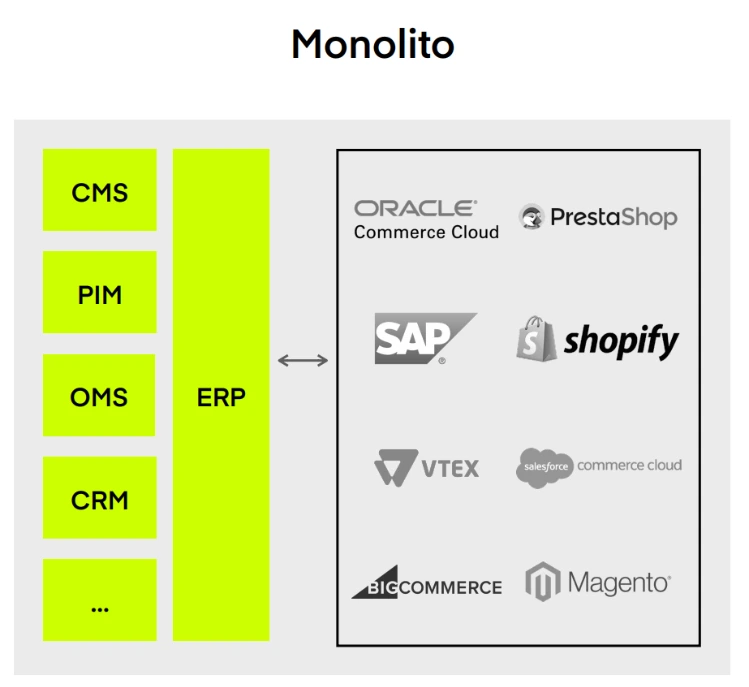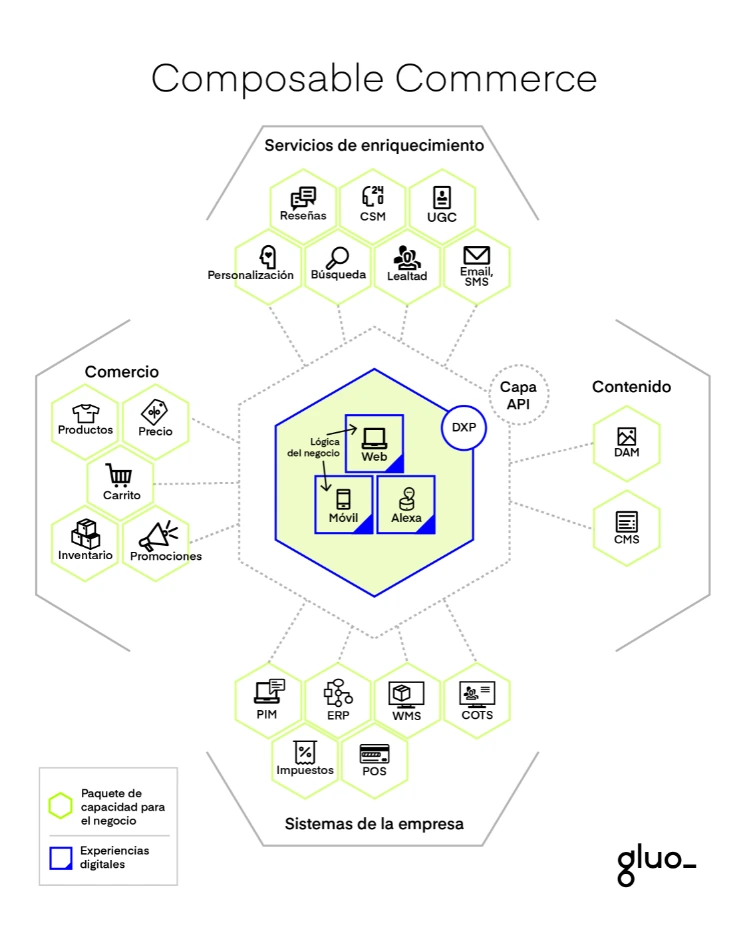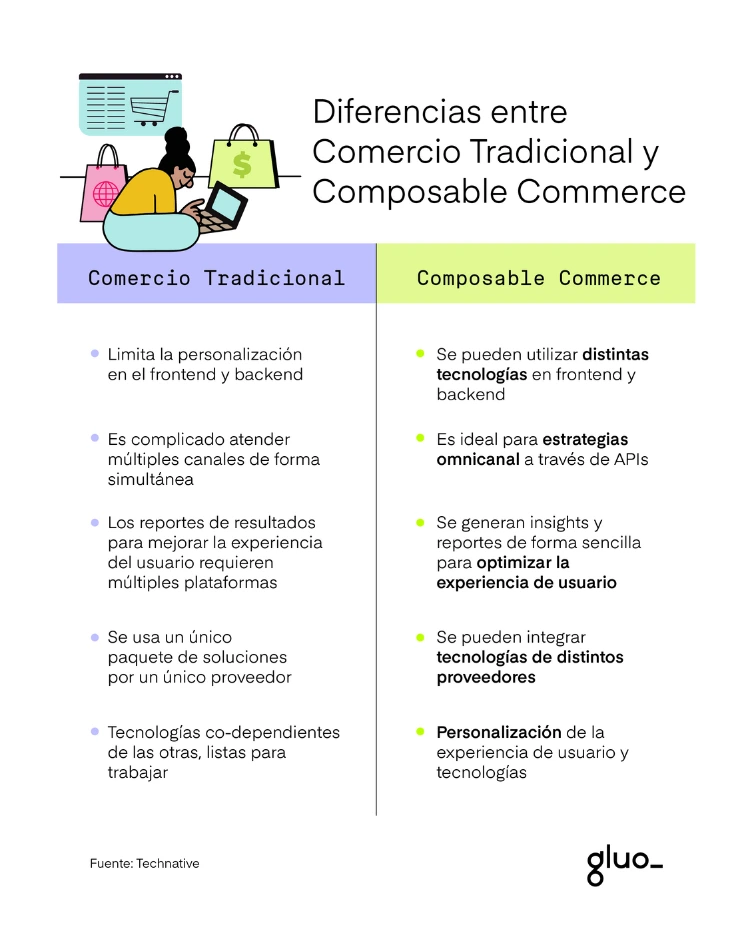Composable Commerce: What is it and what are its advantages?

Composable Commerce is a software development approach that consists of selecting the best e-commerce technologies and unifying them into a single custom application.
When a company opens its online store, it faces the challenge of choosing the e-commerce platform that best suits the business needs. Selecting the right e-commerce platform, implementing it, and launching an online store takes months of work and a lot of financial resources from a company. Changing platforms again will require another large financial investment and time investment. That is why many companies prefer to use their platform for many years before switching.
However, as time goes by and your e-commerce grows, your needs increase and you realize that your e-commerce platform limits you in many of the changes you want to make. Whether you want to redesign the interface, improve the search engine, generate more content, or offer a better user experience, it seems that the platform you selected in the beginning is not enough.
That is why many companies face the question, "Should I change my e-commerce platform?" Composable Commerce offers an alternative to this problem.
What is Composable Commerce?
Composable Commerce is a software development approach that involves selecting the best e-commerce technologies and unifying them into a single, customized application.
We usually see e-commerce platforms as a kind of monolith, where it's "all or nothing", a single piece that we can't change or improve its parts. The most we can do is connect it to other pieces of technology such as a CMS, PIM, OMS, CRM, or ERP.

However, this is not entirely true.
Composable Commerce proposes that the software architecture of your ecommerce can be more like a puzzle or an application made up of multiple components. In which, you can integrate different specialized technologies into your ecommerce through APIs.
In this way, if you don't like the functionality or performance of a piece of your ecommerce, you can replace it with a better

In this way, if you don't like the functionality or performance of a piece of your e-commerce, you can replace it with a better technology.
The reality is that no e-commerce platform is perfect, they all have a series of strengths and weaknesses. No manufacturer can offer all the necessary functionalities to meet the needs of today's digital consumers.
So it's important that those components of your e-commerce platform that are not providing the best experience are replaced by specialized technologies.
You don't like the search engine of your e-commerce?
You can replace it with a search technology leader like Algolia, a search engine focused on providing the best user experience.
Or if you feel that the customization of your e-commerce is not the best, you can replace this piece with a technology like Dynamic Yield, a customization engine that learns from your customers' consumption behavior and then shows them products according to their own interests.
The only key piece of your e-commerce platform that you shouldn't change, are its commerce capabilities such as: order management, inventory, catalog management, among others.
The other pieces can be changed, replaced or improved.

Advantages of Composable Commerce
Integrates the best technologies into your e-commerce
Composable allows companies to integrate and combine different technologies and services to optimize their online store.
By using APIs and microservices, the best tools from different providers can be connected and used to improve the customer shopping experience and increase operational efficiency.
This allows companies to have greater control over their online store, without relying on a single platform.
With Composable, it is possible to integrate solutions from different providers such as: search platforms, CMS, DAM, PIM, personalization engines, customer service, reviews and more.
Customize your digital experience
The Composable architecture is compatible with Headless Commerce.
Headless is a software structure that separates the Frontend (the user interface and experience) from the Backend (systems and processes for managing products, orders, and payments).
Under this structure, the Frontend is managed by the marketing team and the Backend is managed by the systems team. Delivering greater control to the marketing team over the user interface and experience.
This way, the team will have greater freedom to design the user interface and experience.
Accelerate the development speed
Composable Commerce is based on the most advanced technologies on the market.
By adopting a component-based architecture, you can use the most modern programming languages, libraries, and tools on the market to develop your e-commerce.
As a result, your development team will be able to hit the market faster.
High scalability and performance
Composable commerce is based on the cloud. This allows companies to access their data and tools from anywhere and at any time, making it easier to manage and monitor their operations.
They also allow for easier and faster scalability, as the provider can assign more resources and processing capacity according to the demand of the users.
Reduces maintenance costs
Composable commerce is based on Cloud Native SaaS technologies, meaning the platform is run on the provider's servers.
Companies do not have to invest in expensive hardware and software or IT teams to maintain and update their platform, as these costs are fully assumed by the provider.
Convert your commerce to omnichannel
Composable Commerce, being a microservice and API-based software architecture, can connect your commerce to multiple channels such as: web, mobile, smartwatches, virtual reality devices, and in-store screens.
Achieving a truly omnichannel e-commerce.
For what type of companies make sense to move to Composable Commerce?
Companies with maturity in their e-commerce, processes and technology
Composable Commerce requires that you already have an e-commerce platform installed and working within your software infrastructure.
Additionally, you will need a multidisciplinary e-commerce team to operate all the new tools and features of your online store. Ideally, within your e-commerce team there should be people from data analytics, marketing, user experience, customer service, and sales to make the most of your software architecture.
Companies with internal or external capabilities to execute strategies
To implement a Composable Commerce architecture in your online store, you need an internal programming team to develop the system at the code level.
Another option is to hire an external software agency to help you build your Composable Commerce and install the best technologies for your site.
Companies that aim to deliver the best experience
The final goal of Composable Commerce is to offer the best user experience to your customers. If currently customer experience is not a priority for your company, maybe transitioning to this model is not a good option.


